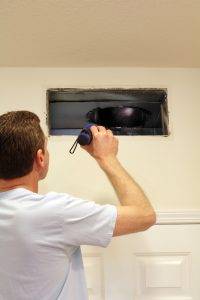One of the best ways to determine if your air ducts are functioning properly is through home air testing to determine whether the air your family is breathing contains pollutants. Let’s face it: we face enough risks every day, between driving on crowded roads in rush hour, playing catch in the front yard with our kids, or entering a teenager’s room without a hazmat suit. Why would we want poor home air quality added to our health risks?
 Causes of Poor Air Quality
There are many reasons a home might have poor air quality. While some of these reasons are well known (like that teenager’s bedroom), others might be surprising. Inadequate ventilation increases indoor pollutant levels because too little outdoor air enters the home while not enough polluted air escapes the home. There are many sources of indoor pollution, none of which are related to the teenager’s room. Heating sources, such as oil, coal, wood, and gas contribute to the pollutants found in the home, as does the deterioration of building materials or furnishings, household cleaning agents and personal grooming products, to name a few. Naturally occurring substances such as radon and biological contaminants—including mold, mildew and bacteria—also contribute to indoor air pollution. In addition, air ducts can become blocked, damaged or disconnected, further increasing the need for home air testing as part of any home maintenance plan.
Need for Home Air Testing
Is home air testing is necessary in your home? Health problems are one of the first indicators that there may be a home air quality problem. If your family uses enough tissues that stock in the makers of Kleenex would make you rich, it is possible you need to have your home air quality tested. Allergy symptoms such as runny noses, sneezing, itchy or watery eyes and coughing are commonly related to poor home air quality, especially if symptoms are worse at home. If you find yourself spending more time at the office simply so you can breathe without problems, it may be time consider having the ductwork and indoor air quality checked in your home.
Air Ducts and Air Quality
Air ducts play an important role in ensuring you breathe clean air in your home. Because air ducts are the silent workhorses of your heating and air conditioning system, it is easy to forget that they need love, too. Mold and other bacteria can grow inside the ducts, potentially leading to significant health problems. Dust and debris can accumulate inside ducts, especially those that have been damaged, which could mean that the dust in your basement, attic or crawlspace is being blown into your home through the duct system. An even more unpleasant “surprise” sometimes found in ductwork are nests of vermin. There’s nothing like realizing that some six-legged creepy crawler or family of mice has made a home in the ductwork, right? If home air testing determines that your home has pollutants, air duct testing is an excellent starting point for determining if the problem lies in the ductwork or elsewhere in your home.
Air duct testing is the logical follow-up to home air testing where the air quality contains pollutants that could cause health problems. If you want more information on how to improve your home air quality, making your home cleaner and healthier, visit our website, or connect with us on Facebook, Twitter, YouTube and LinkedIn.
Causes of Poor Air Quality
There are many reasons a home might have poor air quality. While some of these reasons are well known (like that teenager’s bedroom), others might be surprising. Inadequate ventilation increases indoor pollutant levels because too little outdoor air enters the home while not enough polluted air escapes the home. There are many sources of indoor pollution, none of which are related to the teenager’s room. Heating sources, such as oil, coal, wood, and gas contribute to the pollutants found in the home, as does the deterioration of building materials or furnishings, household cleaning agents and personal grooming products, to name a few. Naturally occurring substances such as radon and biological contaminants—including mold, mildew and bacteria—also contribute to indoor air pollution. In addition, air ducts can become blocked, damaged or disconnected, further increasing the need for home air testing as part of any home maintenance plan.
Need for Home Air Testing
Is home air testing is necessary in your home? Health problems are one of the first indicators that there may be a home air quality problem. If your family uses enough tissues that stock in the makers of Kleenex would make you rich, it is possible you need to have your home air quality tested. Allergy symptoms such as runny noses, sneezing, itchy or watery eyes and coughing are commonly related to poor home air quality, especially if symptoms are worse at home. If you find yourself spending more time at the office simply so you can breathe without problems, it may be time consider having the ductwork and indoor air quality checked in your home.
Air Ducts and Air Quality
Air ducts play an important role in ensuring you breathe clean air in your home. Because air ducts are the silent workhorses of your heating and air conditioning system, it is easy to forget that they need love, too. Mold and other bacteria can grow inside the ducts, potentially leading to significant health problems. Dust and debris can accumulate inside ducts, especially those that have been damaged, which could mean that the dust in your basement, attic or crawlspace is being blown into your home through the duct system. An even more unpleasant “surprise” sometimes found in ductwork are nests of vermin. There’s nothing like realizing that some six-legged creepy crawler or family of mice has made a home in the ductwork, right? If home air testing determines that your home has pollutants, air duct testing is an excellent starting point for determining if the problem lies in the ductwork or elsewhere in your home.
Air duct testing is the logical follow-up to home air testing where the air quality contains pollutants that could cause health problems. If you want more information on how to improve your home air quality, making your home cleaner and healthier, visit our website, or connect with us on Facebook, Twitter, YouTube and LinkedIn.

Home air testing is one of the best ways to determine if your air ducts are working properly, as the experts at Spencer AC & Heating explain in part one of this three-part series.




